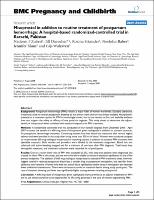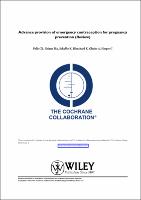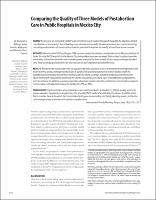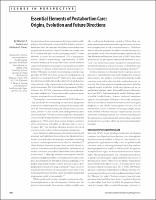Misoprostol in addition to routine treatment of postpartum hemorrhage: A hospital-based randomized-controlled trial in Karachi, Pakistan

Visualizar/
Data
2008-08Autor
Zuberi, Nadeem
Durocher, Jill
Sikander, Rozina
Baber, Neelofur
Blum, Jennifer
Walraven, Gijs
Metadata
Mostrar registro completoResumo
Background: Postpartum hemorrhage (PPH) remains a major killer of women worldwide. Standard uterotonic
treatments used to control postpartum bleeding do not always work and are not always available. Misoprostol's
potential as a treatment option for PPH is increasingly known, but its use remains ad hoc and available evidence
does not support the safety or efficacy of one particular regimen. This study aimed to determine the adjunct
benefit of misoprostol when combined with standard oxytocics for PPH treatment.
Methods: A randomized controlled trial was conducted in four Karachi hospitals from December 2005 – April
2007 to assess the benefit of a 600 mcg dose of misoprostol given sublingually in addition to standard oxytocics
for postpartum hemorrhage treatment. Consenting women had their blood loss measured after normal vaginal
delivery and were enrolled in the study after losing more than 500 ml of blood. Women were randomly assigned
to receive either 600 mcg sublingual misoprostol or matching placebo in addition to standard PPH treatment with
injectable oxytocics. Both women and providers were blinded to the treatment assignment. Blood loss was
collected until active bleeding stopped and for a minimum of one hour after PPH diagnosis. Total blood loss,
hemoglobin measures, and treatment outcomes were recorded for all participants.
Results: Due to a much lower rate of PPH than expected (1.2%), only sixty-one patients were diagnosed and
treated for their PPH in this study, and we were therefore unable to measure statistical significance in any of the
primary endpoints. The addition of 600 mcg sublingual misoprostol to standard PPH treatments does, however,
suggest a trend in reduced postpartum blood loss, a smaller drop in postpartum hemoglobin, and need for fewer
additional interventions. Women who bled less overall had a significantly smaller drop in hemoglobin and received
fewer additional interventions. There were no hysterectomies or maternal deaths among study participants. The
rate of transient shivering and fever was significantly higher among women receiving misoprostol
Conclusion: A 600 mcg dose of misoprostol given sublingually shows promise as an adjunct treatment for PPH
and its use should continue to be explored for its life-saving potential in the care of women experiencing PPH.
Trial Registration: Clinical trials.gov, Registry No. NCT00116480
Collections
- Recursos Informativos [175]
Itens relacionados
Apresentado os itens relacionados pelo título, autor e assunto.
-
Advance provision of emergency contraception for pregnancy prevention (Review)
Polis, Chelsea; Grimes, David; Schaffer, Kate; Blanchard, Kelly; Glasier, Anna; Harper, Cynthia (The Cochrane Collaboration, 2010)Background Emergency contraception can prevent pregnancy when taken after unprotected intercourse.Obtaining emergency contraception within the recommended time frame is difficult for many women. Advance provision could ... -
Comparing the quality of three models of postabortion care in public hospitals in Mexico City
Billings, Deborah; Fuentes Velásquez, Jaime; Pérez-Cuevas, Ricardo (IPAS, 2003)CONTEXT: Each year, an estimated 120,000 women in Mexico seek treatment in public hospitals for abortion-related complications--the country's fourth leading cause of maternal mortality. Models of postabortion care emphasizing ... -
Essential elements of postabortion care: origins, evolution and future directions
Corbett, Maureen R; Turner, Katherine L (Guttmacher, 2003)In this comment, we chronicle the development and expansion of a postabortion care model designed to promote interventions that address abortion-related public health concerns even when abortion laws and policies are ...


